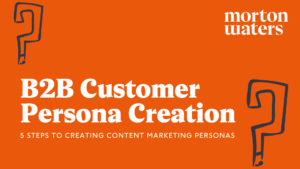We’ve had many people ask us whether we find writing B2B content dull.
If you ask our team, it’s a resounding NO.
B2B content shouldn’t be Boring2Boring
In fact, we love creating content for our B2B clients, helping them to find a voice that educates their audiences on often complex topics in a compelling way.
What’s dull about Mission Impossible-style security systems? Or clever sensors installed in tunnels beneath the streets of London during major construction works, to protect the people and assets above from risk due to unforeseen changes in earth movement?
It’s systems and equipment like this that we find fascinating. And, if the content we’re creating helps to solve problems for the audience, equipping people with knowledge or tools which helps them to do their jobs, it’s unlikely that our clients’ audiences will find the content dull.
It is true, however, that some B2B content is more engaging than others. But why? Here are a few tricks to help you make your B2B content stand out.
1. Understand your audience
Taking the time to understand the behaviours and influencing factors of your target audiences should be the starting point of any content creation project.
How can you produce engaging content if you don’t know what makes your audiences tick?
Here’s how. Download our ebook, it’s a great starting point.
2. Get to the point
Thinking about written content specifically, people read digital copy differently. They tend to scan a web page looking for key bits of information as quickly as possible, rather than reading large chunks of text. So don’t waffle.
3. Rhythm and the rule of three
Think about some of these well-known phrases and consider why you remember them:
- ‘Friends, Romans, countrymen’
- ‘Blood, sweat and tears’
- ‘Find, win and keep customers’
There is something pleasurable about reading and saying phrases in a pattern of three. Phrases such as these have a natural rhythm, are easy to read and subconsciously just feel right.
4. Use anaphora, the posh word for repetition
To learn something parrot-fashion, you repeat, repeat, repeat. The more you say something, the more likely it is to stick.
Consider some of the great historical speeches by Winston Churchill or Martin Luther King, for example:
“…we shall fight on the beaches, we shall fight on the landing grounds, we shall fight in the fields and in the streets, we shall fight in the hills…” (Winston Churchill)
Using repetition, you can emphasise the key points you want your audience to remember.
5. Be brutal with pace – give your copy space
As already mentioned, when people read on screen they scan for key snippets of information. If a reader is faced with a huge block of dense copy, they are unlikely to make it to the end and take it in what you’re saying.
Help them find what they’re looking for by:
- Breaking text into short paragraphs,
- Adding subheadings
- Using bullet points
- Inserting images
- Using bold text
Giving a reader variety adds pace and energy to your copy, making it more interesting to read.
6. Alliteration
It’s not a coincidence that alliteration is used a lot in poetry. Playing with words in this way reemphasises the message and makes your copy more memorable. It’s used a lot in the naming of businesses too…
- Ted Talks
- Lululemon
- Range Rover
Don’t go overboard just for the sake of it though, as it can detract from your message and become irritating to read.
7. Rhyme time
When you use assonance, or rhyme, at the end of lines or in the middle of a sentence it can help your message to stick in the reader’s mind.
8. Tell a story
Pointing out that people love stories is nothing new. Appealing to their experiences of the real world resonates more with readers and can help with their understanding of complex messages. It also makes your copy more fun to read.
In this recent blog we wrote for our client, 56 Degrees, about the differences between ‘back-end’ and ‘front-end’ web development, we used a restaurant metaphor to help tell the story.
If you can tell a story which evokes emotion, even better, as people make decisions far more based on emotions, rather than logic.
9. Consider your choice of language
People tend to be drawn towards one of the three main sensory receivers: visual, auditory and kinesthetic.
You can deliver sensory impact through your copy by using these three different kinds of sensory language.
Visual communicators respond to language which describes the appearance of things, and might say something like
“I see what you mean”
Look to use “visual” words and phrases, for example,
Words: see, look, view, focus, appear
Phrases: beyond a shadow of a doubt, bird’s eye view
Auditory communicators respond to language that picks up on how something sounds, and might be heard saying
“I hear you”
For auditory communicators, use some of the following words and phrases:
Words: hear, listen, sounds, resonate
Phrases: rings a bell, manner of speaking, lend me your ear, hold your tongue
Kinesthetic communicators are more about the feeling, and might use the phrase
“I grasp what you mean”
Kinesthetics will respond well to the following words and phrases:
Words: feel, touch, grasp, concrete
Phrases: get a hold of, catch on, tap into, boils down to, hand in hand
Always keep in mind that different people respond to different language, so think about your typical audience. You’re on to a winner if you can incorporate all three in one piece of copy.
10. Mix up content formats
A lot of the examples we’ve touched on above relate to the written or read word but they can also be applied to other forms of content, such as video, infographics and audio.
Experimenting with different formats will also help your content connect with people who respond to the three different sensory receivers.
If you’ve made it to the bottom of this article, hopefully I’ve managed to create my own piece of engaging B2B content by applying some of the above tactics!
As always, we’d love to hear your thoughts so please feel free to share. Or, if you’d like to speak to us about the content creation services we provide, please get in touch.

